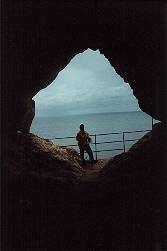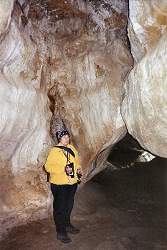Għar Ħasan
Hasan’s Cave
Useful Information

© Tony Oldham, 22-FEB-2002, with kind permission.
| Location: |
Triq Għar Ħasan, Żurrieq, Malta.
Hal Far, Malta. 2 km south-west of Kalafrana, well signposted from the Kalafrana/Zurrieq road. (35.8067643, 14.5182220) |
| Open: |
no restrictions. [2025] |
| Fee: |
free. [2025] |
| Classification: |
 Karst Cave Karst Cave
|
| Light: | bring torch |
| Dimension: | L=387 m. |
| Guided tours: | self guided |
| Photography: | allowed |
| Accessibility: | no |
| Bibliography: |
Charles Savona-Ventura, A. Mifsud (2000):
Hasan’s Cave: Geology, Folklore and Antiquities,
44 pp, 14 plates, some in colour.
A very expensive little book, but the only monograph on this topic! SB
Trevor R. Shaw (1950): Hassan’s Cave, Malta, BSA Cave Science (13) 191-192 S Maria Guagnin, Vincent Haburaj, Huw S. Groucutt et al. (2022): Evaluating possible prehistoric cave art in the central Mediterranean: Analyses of pigment traces and identification of taphonomic processes at Għar Ħasan, Malta, Journal of Archaeological Science: Reports Volume 47, February 2023, 103815. DOI pdf Andrew Leith Adams (1870): Notes of a Naturalist in the Nile Valley and Malta: A Narrative of Exploration and Research in Connection with the Natural History, Geology, and Archæology of the Lower Nile and Maltese Islands Edmonston and Douglas. google HathiTrust archive.org |
| Address: | Għar Ħasan, Triq Għar Ħasan, Żurrieq, Malta |
| As far as we know this information was accurate when it was published (see years in brackets), but may have changed since then. Please check rates and details directly with the companies in question if you need more recent info. |
|
History
| 1860s | palaeontological and archaeological potential assessed the naturalist Andrew Leith Adams and the antiquarian Walter Strickland. |
| 1950s | excavations by Trevor R. Shaw, unpublished, survey published. |
| 1987 | explored by Italian archaeologists from the Centro Camuno di Studi Preistorici led by Prof. Emanuel Anati, Professor of Palaeoethnology at Lecce University. |
| DEC-2017 | investigated by an interdisciplinary team of archeologists and Quaternary scientists as part of the Malta Quaternary Palaeoecologies Project. |
| SEP-2019 | five-day field season with permission from the Superintendence of Cultural Heritage (Malta). |
Description

© Tony Oldham, 22-FEB-2002, with kind permission.

© Tony Oldham, 22-FEB-2002, with kind permission.

© Tony Oldham, 22-FEB-2002, with kind permission.
We classified Għar Ħasan (Hasan’s Cave) as a show cave, which is not really true though. This is a semi-wild cave, which has a car park, an access trail, a trail inside the cave, even a railing in the cave portal towards the sea. But there is no light, no guided tours, and most important, the cave is not gated. The descriptions (and the pages) are now 20 years old and a little update is necessary. Obviously, a cave does not change in 20 years, but probably access restrictions or even the trails.
To visit the cave, park at the free car park at the end of Triq Għar Ħasan, across the road there is a fenced area. Its rather unclear why this area was fenced, because that is futile, as there is a wide gap on the right side. Some buildings which are rammed up look a little like a ticket office with souvenir shop, probably this was once planned as a real show cave wit tickets, but that was at least 40 years ago. Once inside return a little along the fence to the concrete trail which leads down towards the sea. At the cliff it turns left and follows the cliff descending to the cave entrance. The portal is 5 m high and 6 m wide. The cave passage formed along a vertical crack and is typically much higher than wide. The walls show erosional forms. There is an opening towards the sea on the right side which offers a great view. Then a second, much larger opening, follows. On the left side is a sort of cave house, a side passage was closed by a wall with a door hole. The passage continues but is now much lower, orientad along a horizontal crack, and it is necessary to stoop. For this part a helmet is definitely a good idea if you have one. The cave is visited in the full length until finally a third opening is reached, where the cave passage ends in the middle of the cliff. From here return the same way.
There is a legend about a guy named Hasan, after whom the cave was named. Of course, he is an Arab with that name, but there are so many different versions of the legend that only two things are the same. His name and he ends up dead.
An Arab named Hasan kidnapped a Maltese farm-girl and sought refuge in this cave, where he kept her imprisoned. He tried to escape from Malta, and managed to make contact with pirates. Lowering the girl down the cliffs to the pirate ship waiting on the sea below, he was surprised by a group of Maltese who had come to rescue the girl. In his excitement, he accidentally let go of the rope and the girl fell to her death. Instead of being caught, Hasan also jumped off the edge.
Saracen Hasan was holding a local girl captive. He made her promise eternal love to him so she would be freed. But she got desperate and jumped off the cliff. Followed by Hasan jumping after her.
Hasan raised hell with the locals, by kidnapping a Maltese girl. They attacked the cave to free her. In a panic, Hasan threw the girl off the cliff and jumped after her.
Hasan kidnapped a Maltese farm-girl and sought refuge in this cave. The kidnapped girl managed to kill her abductor and returned to her village.
There once was a man called Hasan, who fell of these cliffs. So the cave was named after him.
All those stories are local lore, there is actually no historic document mentioning Hasan. As far as we know there is actually not much history about the cave. But it is listed as an archaeological site, and there actually were excavations since the 1860s. The cave was first explored by the naturalist Andrew Leith Adams and the antiquarian Walter Strickland in the 1860s. They dug a deep trench in the soil, "in quest of organic remains". Later more excavations followed, but as far as we interpret the publications the findings were not really spectacular. That’s actually not surprising, as the cave is located in the middle of the cliff, and thus it was not very well accessible. In other words, prehistoric man did not visit this cave because he did not have the required climbing gear. The current access by stone staircase was first built in the 1890s and later renovated in the late 20th century.
According to Prof. Charles Savona-Ventura from the L-Università ta’ Malta (UM) there are cave paintings in the cave. They were discovered quite recently, about 1986, by Italian archaeologists around Prof Anati from Lecce. His publication caused some criticism about their age. Some say they could be graffiti or even intentional fakes. The main problem with those paintings was the fact that they actually contradicted the established history of Malta. Some paintings were interpreted as Neanderthal, but so far the theory said that Neanderthals never came to Malta. In a recent research in 2022, graffiti from the last century and older rock art were distinguished by determining chemical and physical properties withe modern technology. The result was that all paintings were actually from the 20th century, except for one which could be older but was contaminated by younger graffiti. However, the cave was vandalized sind the 1990s over decades and most paintings were already destroyed at this time.
There are many legends about this cave on the southern coast, all featuring the Saracen, Hasan, who took refuge here, and most of them referring to at least one young maiden that he abducted and imprisoned. The cave setting is most spectacular. From the car park, a footpath over a "karst garden", leads to a flight of 25 precarious steps, heading down the limestone cliff high over the sea. A walk along a narrow path, carved out of the cliff, protected by a very rusty guard rail leads to the entrance. Hasan, apparently, entered the cave from below via a rope tethered at the entrance. The main entrance to the cave is 5 m high and 6 m wide, and the entrance is of similar dimensions for the first 20 m. In the top of this passage is a roof tube, sometimes separated from the main passage by a thin layer of rock and sometimes just a half-tube in the roof. Partially enlarged master joints can be seen crossing the main passage.
Most of them come to a dead end, but a large one extends for 48 m and 73 m respectively to two further entrances along the cliff face. At the eastern entrance there is a man made circular chamber, with obvious pick marks on the walls, and a stone bench around the edge, it has been speculated that this was, in fact, where Hasan lived.
The cave is almost bereft of formations, although there are some small stalactites and some splash deposits. A broken iron gate bars the inner recess to the cave. Here, according to Savona-Ventura are some cave paintings, but, as they were only discovered in the last 10 years, their antiquary is in some dispute. The cave is heavily trashed and there are syringes and guano in evidence. Watch where you walk and wear gloves. The lady who sits in a hut in the car park will lend you a torch if you give her a tip. Otherwise take your own as little of the cave can be seen from the daylight which filters in from the entrances.
Text by Tony Oldham (2002). With kind permission.
 Search DuckDuckGo for "Hasan’s Cave"
Search DuckDuckGo for "Hasan’s Cave" Google Earth Placemark
Google Earth Placemark OpenStreetMap
OpenStreetMap Għar Ħasan
Għar Ħasan  - Wikipedia (visited: 10-FEB-2025)
- Wikipedia (visited: 10-FEB-2025) Mysterious Ghar Hasan Cave (visited: 10-FEB-2025)
Mysterious Ghar Hasan Cave (visited: 10-FEB-2025) Index
Index Topics
Topics Hierarchical
Hierarchical Countries
Countries Maps
Maps